Nordic OCD & Related Disorders Consortium: Rationale, design, and methods
| dc.contributor.author | Mataix-Cols, David | |
| dc.contributor.author | Hansen, Bjarne | |
| dc.contributor.author | Mattheisen, Manuel | |
| dc.contributor.author | Karlsson, Elinor K. | |
| dc.contributor.author | Addington, Anjené M. | |
| dc.contributor.author | Boberg, Julia | |
| dc.contributor.author | Djurfeldt, Diana R. | |
| dc.contributor.author | Halvorsen, Matthew | |
| dc.contributor.author | Lichtenstein, Paul | |
| dc.contributor.author | Solem, Stian | |
| dc.contributor.author | Lindblad-Toh, Kerstin | |
| dc.contributor.author | Haavik, Jan | |
| dc.contributor.author | Kvale, Gerd | |
| dc.contributor.author | Rück, Christian | |
| dc.contributor.author | Crowley, James J. | |
| dc.date.accessioned | 2019-11-20T13:25:24Z | |
| dc.date.available | 2019-11-20T13:25:24Z | |
| dc.date.created | 2019-09-04T10:09:16Z | |
| dc.date.issued | 2019 | |
| dc.identifier.citation | American Journal of Medical Genetics Part B: Neuropsychiatric Genetics. 2019, 1-13. | nb_NO |
| dc.identifier.issn | 1552-4841 | |
| dc.identifier.uri | http://hdl.handle.net/11250/2629533 | |
| dc.description.abstract | Obsessive‐compulsive disorder (OCD) is a debilitating psychiatric disorder, yet its etiology is unknown and treatment outcomes could be improved if biological targets could be identified. Unfortunately, genetic findings for OCD are lagging behind other psychiatric disorders. Thus, there is a pressing need to understand the causal mechanisms implicated in OCD in order to improve clinical outcomes and to reduce morbidity and societal costs. Specifically, there is a need for a large‐scale, etiologically informative genetic study integrating genetic and environmental factors that presumably interact to cause the condition. The Nordic countries provide fertile ground for such a study, given their detailed population registers, national healthcare systems and active specialist clinics for OCD. We thus formed the Nordic OCD and Related Disorders Consortium (NORDiC, www.crowleylab.org/nordic), and with the support of NIMH and the Swedish Research Council, have begun to collect a large, richly phenotyped and genotyped sample of OCD cases. Our specific aims are geared toward answering a number of key questions regarding the biology, etiology, and treatment of OCD. This article describes and discusses the rationale, design, and methodology of NORDiC, including details on clinical measures and planned genomic analyses. | nb_NO |
| dc.language.iso | eng | nb_NO |
| dc.publisher | Wiley | nb_NO |
| dc.title | Nordic OCD & Related Disorders Consortium: Rationale, design, and methods | nb_NO |
| dc.type | Journal article | nb_NO |
| dc.type | Peer reviewed | nb_NO |
| dc.description.version | acceptedVersion | nb_NO |
| dc.source.pagenumber | 1-13 | nb_NO |
| dc.source.journal | American Journal of Medical Genetics Part B: Neuropsychiatric Genetics | nb_NO |
| dc.identifier.doi | 10.1002/ajmg.b.32756 | |
| dc.identifier.cristin | 1721345 | |
| dc.description.localcode | Locked until 19.8.2020 due to copyright restrictions. This is the peer reviewed version of an article, which has been published in final form at [https://doi.org/10.1002/ajmg.b.32756]. This article may be used for non-commercial purposes in accordance with Wiley Terms and Conditions for Self-Archiving. | nb_NO |
| cristin.unitcode | 194,67,40,0 | |
| cristin.unitname | Institutt for psykologi | |
| cristin.ispublished | true | |
| cristin.fulltext | preprint | |
| cristin.qualitycode | 1 |
Tilhørende fil(er)
Denne innførselen finnes i følgende samling(er)
-
Institutt for psykologi [2883]
-
Publikasjoner fra CRIStin - NTNU [37177]
